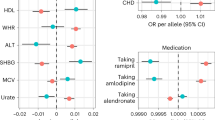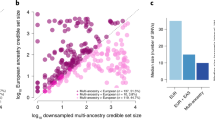Abstract
Until recently, progress in identification of the genetic variants influencing predisposition to common forms of diabetes and obesity has been slow, a sharp contrast to the large number of genes implicated in rare monogenic forms of both conditions. Recent advances have transformed the situation, however, enabling researchers to undertake well-powered scans able to detect association signals across the entire genome. For type 2 diabetes, the six high-density genome-wide association studies so far performed have extended the number of loci harboring common variants implicated in diabetes susceptibility into double figures. One of these loci, mapping to the fat mass and obesity associated gene (FTO), influences diabetes risk through a primary effect on fat mass, making this the first common variant known to influence weight and individual risk of obesity. These findings offer two main avenues for clinical translation. First, the identification of new pathways involved in disease predisposition—for example, those influencing zinc transport and pancreatic islet regeneration in the case of type 2 diabetes—offers opportunities for development of novel therapeutic and preventative approaches. Second, with continuing efforts to identify additional genetic variants, it may become possible to use patterns of predisposition to tailor individual management of these conditions.
Key Points
-
Genome-wide scans to detect evidence of association between common DNA variants and common disease are now technically possible
-
Application of these methods to type 2 diabetes and obesity has led to identification of several novel genes that influence predisposition to these conditions and highlighted a number of entirely new etiological pathways
-
The expectation is that these methods will contribute to the development of novel therapeutic strategies and, in the future, to efforts to use individual genetic profiling in the clinical management of these conditions
This is a preview of subscription content, access via your institution
Access options
Subscribe to this journal
Receive 12 print issues and online access
$209.00 per year
only $17.42 per issue
Buy this article
- Purchase on Springer Link
- Instant access to full article PDF
Prices may be subject to local taxes which are calculated during checkout
Similar content being viewed by others
References
Zimmet P et al. (2001) Global and societal implications of the diabetes epidemic. Nature 414: 782–787
Owen KR and McCarthy MI (2007) Genetics of type 2 diabetes. Curr Opin Genet Dev 17: 239–244
Vaxillaire M et al. (2004) Kir6.2 mutations are a common cause of permanent neonatal diabetes in a large cohort of French patients. Diabetes 53: 2719–2722
Gloyn AL et al. (2004) Activating mutations in the gene encoding the ATP-sensitive potassium-channel subunit Kir6.2 and permanent neonatal diabetes. N Engl J Med 350: 1838–1849
O'Rahilly S (2007) Human obesity and insulin resistance: lessons from experiments of nature. Biochem Soc Trans 35: 33–36
Farooqi IS and O'Rahilly S (2007) Genetic factors in human obesity. Obes Rev 8 (Suppl 1): 37–40
Farooqi IS et al. (1999) Effects of recombinant leptin therapy in a child with congenital leptin deficiency. N Engl J Med 341: 879–884
Wang WYS et al. (2005) Genome-wide association studies: theoretical and practical concerns. Nat Rev Genet 6: 109–118
Risch N and Merikangas K (1996) The future of genetic studies of complex human diseases. Science 273: 1516–1517
Hirschhorn JN and Altshuler D (2002) Once and again—issues surrounding replication in genetic association studies. J Clin Endocrinol Metab 87: 4438–4441
Altshuler D et al. (2000) The common PPARγ Pro12Ala polymorphism is associated with decreased risk of type 2 diabetes. Nat Genet 26: 76–80
Semple RK et al. (2006) PPAR γ and human metabolic disease. J Clin Invest 116: 581–589
Sagen JV et al. (2004) Permanent neonatal diabetes due to mutations in KCNJ11 encoding Kir6.2: patient characteristics and initial response to sulfonylurea therapy. Diabetes 53: 2713–2718
Barroso I et al. (1999) Dominant negative mutations in human PPARγ associated with severe insulin resistance, diabetes mellitus and hypertension. Nature 402: 880–883
Grant SFA et al. (2006) Variant of transcription factor 7-like 2 (TCF7L2) gene confers risk of type 2 diabetes. Nat Genet 38: 320–323
Helgason A et al. (2007) Refining the impact of TCF7L2 gene variants on type 2 diabetes and adaptive evolution. Nat Genet 39: 218–225
Groves CJ et al. (2006) Association analysis of 6,736 U.K. subjects provides replication and confirms TCF7L2 as a type 2 diabetes susceptibility gene with a substantial effect on individual risk. Diabetes 55: 2640–2644
Loos RJF et al. (2007) TCF7L2 polymorphisms modulate proinsulin levels and β-cell function in a British Europid population. Diabetes 56: 1943–1947
Yi F et al. (2005) TCF-4 mediates cell type-specific regulation of proglucagon gene expression by β-catenin and glycogen synthase kinase-3β. J Biol Chem 280: 1457–1464
International HapMap Consortium (2005) A haplotype map of the human genome. Nature 437: 1299–1320
Pe'er I et al. (2006) Evaluating and improving power in whole-genome association studies using fixed marker sets. Nat Genet 38: 663–667
Barrett JC and Cardon LR (2006) Evaluating coverage of genome-wide association studies. Nat Genet 38: 659–662
Fan J-B et al. (2006) Highly parallel genomic assays. Nat Rev Genet 7: 632–644
Zeggini E et al. (2007) Replication of genome-wide association signals in UK samples reveals risk loci for type 2 diabetes. Science 316: 1336–1341
Steinthorsdottir V et al. (2007) A variant in CDKAL1 influences insulin response and risk of type 2 diabetes. Nat Genet 39: 770–775
Sladek R et al. (2007) A genome-wide association study identifies novel risk loci for type 2 diabetes. Nature 445: 881–885
Scott LJ et al. (2007) A genome-wide association study of type 2 diabetes in Finns detects multiple susceptibility variants. Science 316: 1341–1345
Salonen JT et al. (2007) Type 2 diabetes whole-genome association study in four populations: the DiaGen consortium. Am J Hum Genet 81: 338–345
Diabetes Genetics Initiative of Broad Institute of Harvard and MIT, Lund University, and Novartis Institutes of Biomedical Research et al. (2007) Genome-wide association analysis identifies loci for type 2 diabetes and triglyceride levels. Science 316: 1331–1336
Winckler W et al. (2007) Evaluation of common variants in the six known maturity-onset diabetes of the young (MODY) genes for association with type 2 diabetes. Diabetes 56: 685–693
Sandhu MS et al. (2007) Common variants in WFS1 confer risk of type 2 diabetes. Nat Genet 39: 951–953
Gudmundsson J et al. (2007) Two variants on chromosome 17 confer prostate cancer risk, and the one in TCF2 protects against type 2 diabetes. Nat Genet 39: 977–983
Myers S et al. (2005) A fine-scale map of recombination rates and hotspots across the human genome. Science 310: 321–324
Bogue CW et al. (2000) Hex expression suggests a role in the development and function of organs derived from foregut endoderm. Dev Dyn 219: 84–89
Hwang DY et al. (2007) Significant change in insulin production, glucose tolerance and ER stress signaling in transgenic mice coexpressing insulin-si RNA and human IDE. Int J Mol Med 19: 65–73
Fakhrai-Rad H et al. (2000) Insulin-degrading enzyme identified as a candidate diabetes susceptibility gene in GK rats. Hum Mol Genet 9: 2149–2158
ENCODE Project Consortium (2007) Identification and analysis of functional elements in 1% of the human genome by the ENCODE pilot project. Nature 447: 799–816
Chimienti F et al. (2004) Identification and cloning of a β-cell-specific zinc transporter, ZnT-8, localized into insulin secretory granules. Diabetes 53: 2330–2337
Wei F-Y et al. (2005) Cdk5-dependent regulation of glucose-stimulated insulin secretion. Nat Med 11: 1104–1108
Ubeda M et al. (2006) Inhibition of cyclin-dependent kinase 5 activity protects pancreatic β cells from glucotoxicity. J Biol Chem 281: 28858–28864
Moritani M et al. (2005) Hypoplasia of endocrine and exocrine pancreas in homozygous transgenic TGF-β1. Mol Cell Endocrinol 229: 175–184
Mettus RV and Rane SG (2003) Characterization of the abnormal pancreatic development, reduced growth and infertility in Cdk4 mutant mice. Oncogene 22: 8413–8421
Marzo N et al. (2004) Pancreatic islets from cyclin-dependent kinase 4/R24C (Cdk4) knockin mice have significantly increased β cell mass and are physiologically functional, indicating that Cdk4 is a potential target for pancreatic β cell mass regeneration in Type 1 diabetes. Diabetologia 47: 686–694
Krishnamurthy J et al. (2006) p16INK4a induces an age-dependent decline in islet regenerative potential. Nature 443: 453–457
Samani NJ et al. (2007) Genomewide association analysis of coronary artery disease. N Engl J Med 357: 443–453
Frayling TM et al. (2007) A common variant in the FTO gene is associated with body mass index and predisposes to childhood and adult obesity. Science 316: 889–894
Scuteri A et al. (2007) Genome-wide association scan shows genetic variants in the FTO gene are associated with obesity related traits. PLoS Genet 3: e115
Dina C et al. (2007) Variation in FTO contributes to childhood obesity and severe adult obesity. Nat Genet 39: 724–726
Finkel T et al. (2007) The common biology of cancer and ageing. Nature 448: 767–774
Stumvoll M et al. (2005) Type 2 diabetes: principles of pathogenesis and therapy. Lancet 365: 1333–1346
Acknowledgements
We would like to acknowledge the Throne-Holst Foundation and Diabetes UK. CM Lindgren is a Scientific Leadership Fellow at the Nuffield Department of Medicine at the University of Oxford.
Author information
Authors and Affiliations
Corresponding author
Ethics declarations
Competing interests
The authors declare no competing financial interests.
Rights and permissions
About this article
Cite this article
Lindgren, C., McCarthy, M. Mechanisms of Disease: genetic insights into the etiology of type 2 diabetes and obesity. Nat Rev Endocrinol 4, 156–163 (2008). https://doi.org/10.1038/ncpendmet0723
Received:
Accepted:
Published:
Issue Date:
DOI: https://doi.org/10.1038/ncpendmet0723
This article is cited by
-
Effects of Chronic and Acute Zinc Supplementation on Myocardial Ischemia-Reperfusion Injury in Rats
Biological Trace Element Research (2017)
-
Spontaneous Physical Activity Defends Against Obesity
Current Obesity Reports (2017)
-
Voluntary exercise under a food restriction condition decreases blood branched-chain amino acid levels, in addition to improvement of glucose and lipid metabolism, in db mice, animal model of type 2 diabetes
Environmental Health and Preventive Medicine (2014)
-
Low-protein diet improves blood and urinary glucose levels and renal manifestations of diabetes in C57BLKS-db/db mice
European Journal of Nutrition (2013)
-
Polycystic ovary syndrome: etiology, pathogenesis and diagnosis
Nature Reviews Endocrinology (2011)



